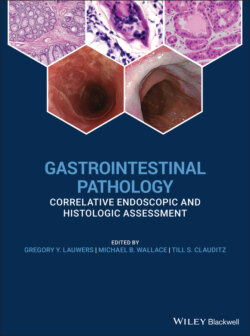Читать книгу Gastrointestinal Pathology - Группа авторов - Страница 77
Clinical and Endoscopic Characteristics
ОглавлениеTypically, there is a temporal relationship between the onset of symptoms and ingestion of a potentially injurious drug. Common symptoms include sudden‐onset chest pain, odynophagia and/or dysphagia that occur within a few hours or days after taking the medication. Severe reflux injury is often an initial diagnostic concern. The chest pain may be pleuritic in nature, mimicking a pulmonary embolism, or may suggest an acute cardiac syndrome. Hematemesis and perforation are rare complications.
Table 2.7 Medications implicated in causing esophagitis and histologic features.
| Medication | Histologic features |
|---|---|
| NSAIDs | Nonspecific, ± crystalline debris |
| Antibiotics (e.g. tetracyclines/doxycycline, clindamycin) | Doxycycline—vascular injury |
| Potassium chloride | Nonspecific |
| Iron | Bluish‐brown crystalline debris, Fe stain + |
| Bisphosphonates (e.g. alendronate) | Nonspecific, ± crystalline debris and multinucleated squamous cells |
| Quinidine | Nonspecific |
| Resins (e.g. kayexalate, bile acid sequestrants) | Kayexalate: Basophilic crystals with “fish scales,” AFB (black), PAD, Diff‐quick bile acid sequestrants:Orange‐black crystals, lack “fish scales,” AFB (yellow) |
| Mycophenolate | Increased apoptosis (GVHD‐like) |
| Taxanes | Mitotic arrest, ring mitoses |
Endoscopically, most lesions occur in the middle third of the esophagus, at the level of the aortic arch, although any level may be involved. Findings include erythema, erosions, ulcers (including “kissing” ulcers), and strictures. Discrete erosions in this region, away from the Z‐line, are an important clue suggesting a drug‐related etiology (Figure 2.15). Occasionally, a diffuse mucosal sloughing pattern has been described.
